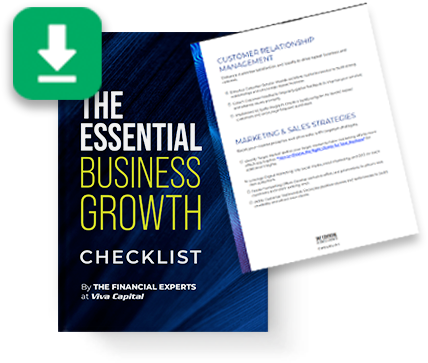
A merchant cash advance (MCA) may seem like an easy way to bridge a funding gap, but it just might be a decision that haunts your small business for some time to come. On this page, you’ll learn the basics of how one works and the benefits and drawbacks, plus explore alternatives.
What is an MCA?
A merchant cash advance, also known as a business cash advance, is a type of funding involving borrowing against a company’s future credit card sales to receive cash now. Instead of taking out a loan, the business requests an advance from a third party. This is usually its credit card processing company, though the funding source may be unrelated to the business. Payments toward the balance are taken in the form of a holdback, which is a percentage scraped off each transaction until the balance is paid off.
Most merchant cash advance companies provide the cash in one lump sum. For example, the business might receive $10,000 and then pay it back over 12 months. Others work like a line of credit. The business might be offered a $10,000 limit and utilize all the funds right away. If $5,000 is paid off in six months, the business can borrow up to $5,000 more.
With that said, MCAs are not loans. They’re categorized as financial transactions or advances. That means they’re not subject to the same rules and regulations as loans, and the funding provider will use something called a multiplier to calculate the cost of borrowing rather than interest.
How is the Cost of an MCA Calculated?
In order to understand the real cost of an MCA, we’ll need to break down the cost of a loan first. Then, we’ll circle back to the same situation but look at how it’s processed as an MCA.
How Loan Fees Are Calculated
A traditional term loan uses the annual percentage rate (APR) structure for fee calculation. This is the yearly interest generated by the borrowed sum that the business pays back to the lender on top of any borrowed funds. APR is used throughout lending because it makes the cost of funds clear. You can easily compare one loan to the next if everyone is using APR.
The average APR in business lending is somewhere between three and seven percent, according to the latest Federal Reserve Small Business Lending Survey. So, let’s say you obtain a $10,000 loan and wind up on the higher end with a seven percent APR and 12 months to pay it back. You’ll pay $700 in interest to borrow the money and will pay off $10,700 in the end.
How MCA Fees Are Calculated
Now, let’s look at the same level of funding and term but through the lens of an MCA. MCAs use multipliers rather than interest. A multiplier is an amount you’ll multiply your advance by to calculate the total payback amount. A typical multiplier is around 1.1 to 1.5, with the average being around 1.3.
Your initial calculation, then, is 1.3 x $10,000. You’ll pay back $13,000, or $2,300 more than you would have with the loan.
When these rates are converted into an APR, as traditional loans do, they can climb as high as 300 percent, according to NerdWallet.
Merchant Cash Advances vs. Traditional Loans: What Business Owners Should Know
For many small business owners, choosing the right type of business financing means weighing short-term access against long-term sustainability. While both merchant cash advances and traditional bank loans provide fast funding, the way each works — and what it means for your business — is very different.
A merchant cash advance loan provides a lump sum upfront, but repayment is pulled directly from card sales until the advance is fully repaid. Since cash advances are not loans, there’s no fixed schedule. Instead, the lender may take a percentage of daily revenue from your business bank account, which creates unpredictable cash flow. In most cases, you’ll repay the advance faster when sales are high, but slower months may extend the timeframe and cost more in the long run. MCA companies are also not subject to the same lending regulations, which means fees can be higher and terms harder to renegotiate.
On the other hand, a traditional bank loan or business line of credit includes set repayment terms, regular monthly payments, and clearer cost structures. These conventional business loan products often require better business credit, time in business, and a solid business bank account history, but they offer greater control and transparency. Some types of small business loans, like those from the Small Business Administration, may even provide favorable terms tailored to your specific business needs.
While some business owners may still choose to use a merchant cash advance for urgent needs, it’s critical to understand the trade-offs. Fast money today may limit flexibility tomorrow, and in many cases, using a business loan or line of credit is a more strategic choice for your business.
Why Do Businesses Take Out MCAs?
Around eight percent of businesses that apply for funding opt for a merchant cash advance, according to the latest Small Business Credit Survey. Although that figure places the popularity of MCAs well behind options like loans and lines of credit or credit cards, it still represents hundreds of thousands of small businesses each year.
Before we start breaking down merchant cash advance disadvantages, let’s look at why businesses consider them in the first place.
Bad Credit
If you have a poor credit history, a merchant cash advance may be one of the few ways you can get funding. Because merchant cash advance lenders have a good idea of what your future sales will be and are taking money off the top before the money reaches you, you don’t have to worry about your credit rating when applying.
Debt Aversion
MCAs are often promoted as debt-free funding because they’re not technically a loan. This type of messaging resonates with businesses that don’t want to take on debt or already have significant debt.
Easy Qualification
About 70 percent of businesses that apply for funding still have a shortfall, per the Small Business Credit Survey. More than 35 percent don’t receive any funding at all. Because MCAs don’t work like loans and don’t have the same requirements for things like existing debts or credit scores, more businesses qualify.
Speed
The approval process for MCAs is fast, and payments may be made within just a few days of approval, instead of weeks or months as with traditional loans. It’s a major draw for businesses that are short on cash but need to make payroll or purchase inventory.
Why You Should Probably Avoid a Merchant Cash Advance
Now, let’s look at some merchant cash advance cons that can help paint a clearer picture of how MCAs can impact businesses.
MCAs Are Expensive
As explored earlier, an average traditional loan will generally top out at a seven percent APR, while the APR of an MCA can hit 300 percent. It’s also worth noting that you won’t necessarily save money if you pay off your balance early. Whereas loans use interest that’s usually calculated daily, and paying off early means you’re not subject to interest after your payoff, MCA fees are added to your balance at the onset. You’ll usually pay the same fees, whether it takes you a week or a year to pay the balance.
The Debt Hole Gets Deeper Very Quickly
MCA providers often refer to their products as “debt-free funding” because the money comes from future sales. In reality, the business is still paying the money back. It just doesn’t write a check to do it, and the total payback amount can be astronomical.
Payments Are Difficult to Track
Your payments to the lender are predictable when you take out a traditional loan. With the example used earlier, you’d pay $892 every month like clockwork.
With an MCA, a portion of your credit card sales is scraped off the top. These holdbacks are typically 10 to 20 percent of your sales. That means the amount you pay each day varies. If your business earns $5,000 on a Monday, and your holdback is 10 percent, your holdback is $500. If your business earns $10,000 on a Saturday, your holdback is $1,000. It can be difficult to know where you stand and how much you have left to pay off at any given time because of this.
Managing Cash Flow Becomes Challenging
Because the amount being held back fluctuates and can change with credit card sales, maintaining a budget and ensuring there’s enough cash for essential expenses like payroll and inventory becomes more difficult. Oftentimes, business owners seek additional loans to cover these expenses and take on more payments than they can reasonably cover.
Lack of Credit Card Sales Can Cause Problems
The fine print in an MCA contract is everything. Some have minimum payments that allow them to scrape more off the top on your slow days. Others have rules that stipulate the business can’t incentivize cash payments. For example, if you realize your MCA holdbacks are eating away at your working capital too much and decide to offer customers five percent off when they pay by cash or check, you could be in violation of your contract.
MCAs Can Be Risky
Merchant cash advances work similarly to payday loans seen in the consumer market. Payday loans have come under fire due to their lack of transparency, high borrowing costs, and short repayment windows. People often take out payday loans to meet an immediate need, then find themselves in a position where they can’t make the payoff in time. As a result, they pay fees to take out an extension. Many find themselves doing this for months or years. Their principal never decreases. They just pay fees, which can amount to thousands of dollars or more over time.
Because of this, payday loans have come under government scrutiny, as reported by Reuters. Described as “predatory debt traps” by the Center for American Progress, payday loans are now subject to additional guidelines. The MCA industry isn’t seeing the same type of reform yet.
Depending on your specific contract, your MCA provider may be allowed to take a higher percentage or withdraw funds from your account. Businesses that can’t comply with their contracts may also be sued and forced to liquidate assets to pay off the debt.
Getting Out of a Merchant Cash Advance Can Be Tricky
There’s a whole industry dedicated to helping businesses get out of their MCAs because it’s so difficult to do on your own. For example, there are attorneys who specialize in finding loopholes in contracts and lenders who refinance MCAs. Although these avenues may sometimes cost less than paying off an especially bad MCA, the process can still drain a company financially.
MCAs Reduce Your Control Over Your Business and Slow Growth
Let’s say you’ve always offered your customers a cash pay discount. Customers rely upon it and leverage it. It’s a business builder for you. Depending on your contract, you may not be able to offer that option to your customers anymore. You might lose control of other aspects of payments and your business, too.
These things damage revenue. Plus, it’s hard to grow a business when you’re paying excessive fees, and money is being scraped off the top of your income every day.
MCAs Are a Temporary Solution to Business Problems
Merchant cash advances generally only make sense in one situation: when a business is experiencing rapid growth and needs working capital to meet new demands. It’s one of the most expensive ways to address that situation, but at least when you make it to the other side and finish payments, you’re in a better place. Your revenue has grown, and your business is more successful.
The problem is that most businesses don’t use MCAs for this reason. They use them when they have a cash flow problem—when they spend too much, don’t bring in the sales they expect, have an emergency, or already have debts eating into their cash flow so much that they can’t cover operational expenses. An MCA is not going to solve these problems. Taking out an MCA just means the business will continue to experience these issues and have holdbacks eating into its cash flow while they’re trying to deal with the initial problem.
Are There Alternatives to Merchant Cash Advances?
If you’re looking for a merchant cash advance alternative, you have lots of options.
Installment Loans
Installment loans work best for businesses that need a lump sum of cash. Around 45 percent of businesses applying for funding opt for a small business loan, per the Small Business Credit Survey. Small business loans tend to have the lowest APRs of all the options, and payments are predictable. However, they’re harder to get because they usually require a credit score over 600, have revenue requirements, and other stringent qualifications.
SBA Loans/ Federal Loans
With an SBA loan, the government guarantees repayment on a portion of the loan to encourage lenders to fund businesses that are underserved. Interest rates are usually lower, but only businesses with a credit score of 690 and higher will generally get funding.
Lines of Credit
A line of credit can work for a business with inconsistent funding needs. For example, if you sometimes need a quick cash injection to cope with growth or a slow-paying client, you can tap into a line of credit as needed, pay off the balance, and then draw from the account as needed again later. However, with this type of loan, you’ll usually need excellent credit to qualify, and the APR will generally be higher than a traditional loan.
Invoice Factoring
One alternative that shares many of the positive traits of MCAs but doesn’t have the same drawbacks is invoice factoring. Think of it as an advance on your unpaid B2B invoices. This is money you’ve already earned because you’ve delivered goods or completed work. However, you would ordinarily have to wait for 30, 60, 90, or more days for the cash because clients can sometimes be slow to pay, have lengthy approval processes, or you’ve simply agreed to wait on payment to make working with you easier and increase sales. With this method, a factoring company purchases the invoice from you at a slight discount, then advances most of the invoice’s value. Any remaining funds are given to you when the client pays.
Because your client is the one ultimately paying the balance, your credit isn’t a major consideration for approval, and it’s much easier to qualify for than a loan or line of credit. Plus, you can get paid as soon as the same day you submit an invoice. This makes it a smarter choice whether your business needs working capital during a period of rapid growth or to bridge cash flow gaps.
Get Invoice Funding with Viva Capital
With decades of experience, industry expertise, and a variety of business funding solutions, Viva Capital can help your business grow stronger. Request a free factoring quote to learn more or get started.
- How Mid-Sized Companies Use Factoring to Drive Growth - May 23, 2025
- 10 Best Cash Flow and Budgeting Tools for Business Owners - May 2, 2025
- Business Factoring Success Stories: How Real Brands Benefit - March 31, 2025



